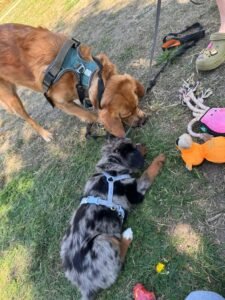
If you’ve ever typed “dog training classes near me” into Google, chances are you’re already looking for the best way to help your young dog succeed. The adolescent stage (usually around 6–18 months old) can be one of the most challenging periods for dog owners. Hormones are kicking in, energy levels are high, and even previously learned commands may suddenly seem “forgotten.”
This is exactly where positive reinforcement training in group classes can make all the difference.
Why Adolescence Is a Tricky Stage for Dogs
During adolescence, dogs often push boundaries and test limits. Common challenges include:
-
Ignoring recall commands (even though they knew them as puppies)
-
Jumping up on people or pulling on the lead
-
Increased reactivity or excitability around other dogs
-
Shorter attention spans
While this stage can be frustrating, it’s also an opportunity to reinforce good habits and strengthen your bond through structured training.
Best Age to Join Dog Training Classes Near Me
The best time to search for dog training classes near me is as early as possible, but it’s never too late to start. Puppies can begin attending classes once they’ve had their initial vaccinations, which helps build social skills and prevent problem behaviours before they develop. However, adolescent dogs—typically between 6 and 18 months—often benefit the most from structured group training, as this stage brings increased energy, independence, and testing of boundaries. Even adult or rescue dogs can thrive in classes, learning new skills while strengthening their bond with their owners. Ultimately, the “best age” is the age your dog is right now—because consistent, positive training works at every stage of life.
What to Expect When Training an Adolescent Dog
Training an adolescent dog can feel very different from working with a puppy. Around 6 to 18 months of age, dogs often go through a “teenage phase” where they want to explore, hormones quick in and they have a mind of their own. You may notice behaviours like pulling on the lead, ignoring recall, jumping up, or becoming more easily distracted—especially around other dogs. Although this is expected, it should be addressed to avoid becoming a habit. But with patience and consistency in training, it can be changed. Positive reinforcement training is especially effective at this stage, helping your dog stay focused, build impulse control, and reinforce the lessons they may have temporarily “forgotten.” With the right approach, your adolescent dog will come out of this phase more confident, responsive, and well-mannered.
The Role of Positive Reinforcement
Positive reinforcement means rewarding your dog for desirable behaviours instead of punishing unwanted ones. Rewards may include treats, praise, toys, or play. In group training classes, this approach is especially powerful because:
-
It Builds Focus in Distracting Environments
In a room full of new dogs and people, distractions are everywhere. By consistently rewarding good choices, your adolescent dog learns to pay attention to you, not just what’s happening around them. -
It Encourages Confidence
Adolescence can bring on fear phases or uncertainty. Positive reinforcement helps your dog associate training with fun and success, boosting their confidence. -
It Strengthens Recall & Impulse Control
Group settings allow for real-life practice of recall and impulse control, with positive reinforcement making these skills stick long-term. -
It Improves Social Skills
Exposure to other dogs in a structured, supportive class helps adolescents learn polite behaviour. Rewards help reinforce calm, appropriate interactions.
Benefits of Group Dog Training Classes
Searching for dog training classes near me is more than just about convenience—it’s about community and consistency. Group classes provide:
-
Professional Guidance: A certified trainer ensures exercises are age-appropriate and effective.
-
Socialization: Your adolescent dog practices greeting and being around other dogs and people and creates positive associations.
- Work around distractions in a controlled environment: If your dog struggles to focus on you around other dogs and people, you need a organise space to practice.
-
Motivation: Learn how to motivate your dog best and the latest techniques for recall, lead walking, settling and others.
-
Routine & Structure: Regular sessions create consistency, which is vital if you’re struggling with a adolescent dog.
Book Dog Training Classes
Adolescence may test your patience, but with the right approach, it’s also a chance to set your dog up for success. Positive reinforcement in group training classes not only addresses unwanted behaviours but also builds focus around distractions, confidence in many different situations and helps them to test less your boundaries.
So, if you’re searching for dog training classes near me, look into our teenager program that prioritise positive reinforcement—you and your dog will both reap the rewards. Book your sport here.


